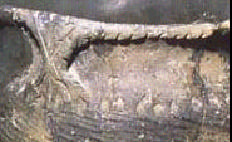
Historic Illinois Indian Decorated Pottery
The historic Illinois Indians used two main techniques to roughen the surfaces of their pots: paddling
and cordmarking. One reason a rough surface was a good idea was that it allowed the person holding it
to have a good grip on it, even when it was wet. Another reason was that rough-textured cooking pots
may improve transfer of heat to the contents. The textured surface is also decorative.
Paddling
Paddling was done when the pot was already formed while
the clay was still a little moist. The Danner grooved pot
shown here (photo below) shows the paddling technique.
Paddling was done by cutting grooves in a wooden paddle,
bracing the inside of the pot with a stone or ceramic anvil,
and then striking the outer surface of the pot's body with the
paddle (this pot shows diagonal grooves).
Cordmarking
Cordmarking was done by wrapping a wooden paddle with
cordage, bracing the inside of the pot with a stone or ce-
ramic anvil, and then striking the outside of the pot with the
paddle to form lines of cord impressions.
Additional Decoration
Punctation and Incising
While the clay was still wet, the rims of pots were sometimes
notched with a stick.
The hourglass-shaped strap handles of the pot have lines incised
(cut) into them, probably made with a pointed stick.
The shoulder of the paddled pot also shows an example of a line
of punctated marks (impressions made with a tool or a finger-
nail).
